Our Daily Practice : Balancing the Doshas
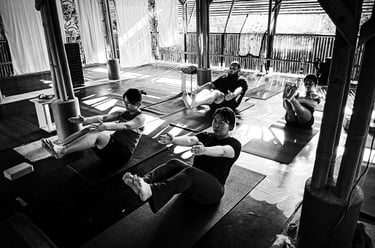

This practice begins with a relaxation in Savasana, allowing the body to settle and the mind to become calm and focused. This grounding moment is crucial as it sets the tone for the rest of the session. This is followed by a breathing exercise, usually Kapalabhati Kriya for the purification of the lungs, air passageways and subtle energy channels.
Opening Sequence:
Next, we move what we've called our opening sequence of asanas, loosely based on the Pawanmuktasana Antirheumatic series, intended to gently loosen the joints and stretch the muscles. The movements are simple yet effective, encouraging mobility in the ankles, knees, hips and shoulders.
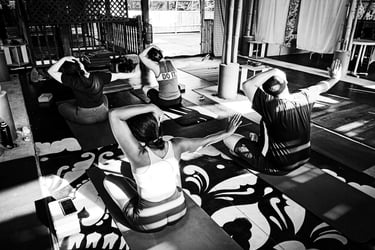

Daily Classes
In our daily classes, we focus on key sequences that align both body and mind, naturally supporting the balance of all three doshas. These sequences not only strengthen the spine and hips but also encourage full-body muscle engagement
Gentle Standing Sequence:
The practice continues with standing sequences designed to gradually energise the body. Our Gentle Standing Sequence helps stabilise Vata dosha by grounding the body and enhancing circulation. These movements connect you to the earth, fostering calmness and mental stability. For novice practitioners, transitioning in and out of Downward Dog can be both a challenge and a highlight. This pose stretches and engages key areas, from the wrists and shoulders to the spine, hips, hamstrings, and calves. The gentle warmth generated during this sequence stimulates energy flow, building Agni (inner fire) and priming the body for further activity or deeper practice. Sun Salutation typically follows, reinforcing the effects.
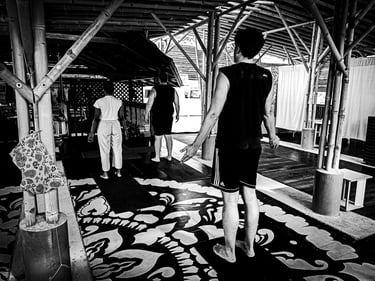

Hip Mobility Sequence:
After the Gentle Standing Sequence, we move into the Hip Mobility Sequence. This dynamic series focuses on improving hip flexibility and strength, further stabilising Vata by encouraging grounded movement. By working through different ranges of motion, this sequence helps to free blocked energy in the hip region, fostering a sense of ease and balance in the body. It serves as a bridge between the standing postures and the spinal sequence, ensuring the hips are fully warmed up and ready for deeper work.
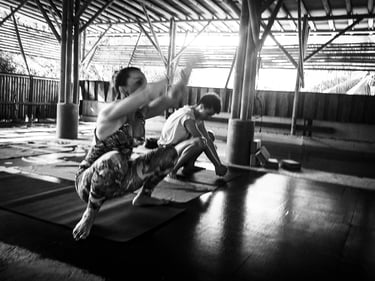

Back Strengthening Sequence:
Next, we transition into a spinal sequence that blends gentle movements with targeted stretches and twists. This is followed by deep spinal lengthening to prepare for strengthening backbends. This sequence balances relaxation with strengthening, with minimal exertion required. The backbends and targeted work in this sequence stimulate Kapha dosha, fostering strength, stability, and endurance. Additionally, the chest opens, encouraging Prana (vital energy) to flow freely, enhancing vitality and reducing Kapha-associated stagnation or lethargy.
Abdominal Sequence:
We move into a reclining abdominal sequence to release tension in the hips, abdomen, and lower back while calming the heart. This sequence balances active core engagement with restorative poses, flowing from core work to relaxing stretches and ending with cooling poses. Core work here is essential for balancing Pitta dosha, as it tones digestive fire (Agni), promoting healthy digestion and metabolism. By supporting the digestive system, this sequence helps regulate emotions like anger and frustration, which can arise with a Pitta imbalance.
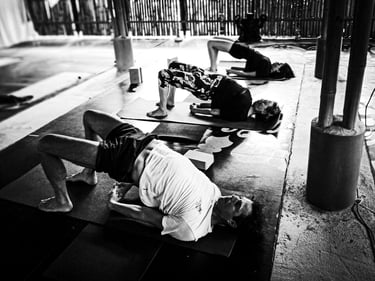

Savasana:
Each class (begins and) ends with guided Savasana to fully restore the energy channels and create balance across all three doshas. Savasana calms the nervous system and stabilises the mind, pacifying Vata.
Weekly Class:
Our weekly practice culminates with Yoga Nidra. This deep relaxation technique releases deep-seated tension and clears energetic blockages, balancing the entire energetic system. The combination of physical asana practice and guided relaxation, provides a comprehensive, dosha-balancing routine, encouraging regular practice for overall health and well-being.
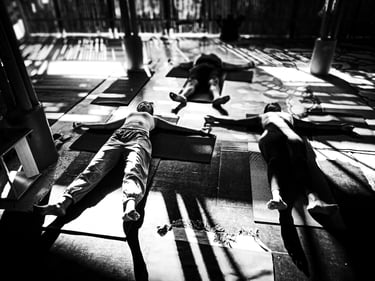

More Insights
